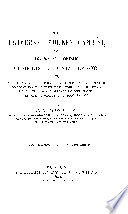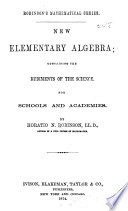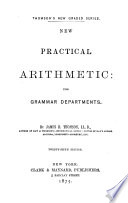 In any series of numbers in arithmetical progression, the sum of the two extremes is equal to the sum of any two terms equally distant from them; as in the latter of the above series 6 + 1=4+3, and =5+2. In any series of numbers in arithmetical progression, the sum of the two extremes is equal to the sum of any two terms equally distant from them; as in the latter of the above series 6 + 1=4+3, and =5+2.  A Concise System of Mathematics ... - Page 58by Alexander Ingram - 1830 - 120 pagesFull view A Concise System of Mathematics ... - Page 58by Alexander Ingram - 1830 - 120 pagesFull view - About this book
 | Joseph Ray - Algebra - 1866 - 420 pages
...Series. — Multiply half the sum, of the two extremes ly the number of terms. It also appears that The sum of the extremes is equal to the sum of any other two terms equally distant from the extremes. 294. The equations l—a+ (n— l)d, and S=(a+r)™,... | |
 | Ezra S. Winslow - Business mathematics - 1872 - 256 pages
...less extreme. The numbers between these, (9, 7, 5,) are tiie means. In every arithmetical progression, the sum of the extremes is equal to the sum of any two means that are equally distant from the extremes ; and is, therefore, equal to twice the middle term,... | |
 | Elias Loomis - Algebra - 1873 - 396 pages
...by term, we have Here a+l is taken n times ; hence 2s=n(a+T), or 324. In an arithmetical progression the sum of the extremes is equal to the sum of any two terms equidistant from the extremes. This principle follows from the preceding demonstration. It may also... | |
 | T. A. Bryce - Business mathematics - 1873 - 370 pages
...extremes, or two terms equidistant from them, are given. We have seen already that in any such series the sum of the extremes is equal to the sum of any two terms that are equidistant from them, and when the number of terms is odd, to twice the middie term. Hence... | |
 | Horatio Nelson Robinson - Algebra - 1874 - 340 pages
...sum of its terms must be twice that of the given series. Hence, in an arithmetical progression, ~ I. The sum of the extremes is equal to the sum of any oilier two terms equally distant from the extremes. II Twice the sum of the series is equal to the... | |
 | James Bates Thomson - 1875 - 392 pages
...the extremes ly the number of terms. RBMAKK. — From the preceding illustration we also see that, The sum of the extremes is equal to the sum of any two terms equidistant from them ; or, to twice the sum of the middle term, if the number of terms Z>« odd. n.... | |
 | James Bates Thomson - Algebra - 1878 - 322 pages
...sum of the extremes by the number of terms. COR.— From the preceding illustration it follows that the sum of the extremes is equal to the sum of any two terms equally distant from the extremes. Thus, in the series, 3, 5, 7, 9, n, 13, the sum of the first and last terms, of the second... | |
 | James Bates Thomson - 1879 - 402 pages
...the extremes by tJte number of terms. REMARK. — From the preceding illustration -ne also see that, The sum of the extremes is equal to the sum of any two term* equidistant from them ; or, to twice the turn of the middle tern; , if the number of terms be... | |
 | A. Melrose - 1881 - 314 pages
...number of terms, and sum of the series, any three being given, the other two may be found. THEOREM. The sum of the extremes is equal to the sum of any two means equally distant from them ; and the doable of any term is equal to the sum of any two terms equidistant... | |
 | James Bates Thomson - Arithmetic - 1882 - 416 pages
...terms. \ a + I FORMULA. — s = — — x n. NOTE. — From the preceding illustration we see that, « The sum of the extremes is equal to the sum of any two terms equidistant from them ; or, to twice the sum of the middle term, if the number of terms be odd. 2.... | |
| |